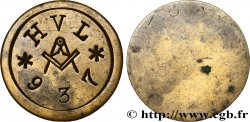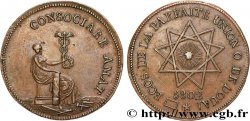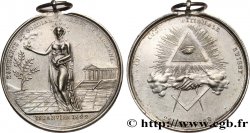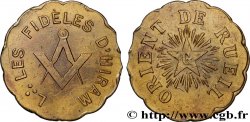fme_582098 - FREEMASONRY Médaille, La concorde, Orient de Sens
60.00 €
Количество
Добавить в корзину

Тип Médaille, La concorde, Orient de Sens
Дата: n.d.
Металл: bronze
Диаметр: 56 mm
Ориентация осей монеты: 12 h.
Век: lisse + 3.7.77 + CY 095
Комментарии о состоянии
Patine sombre hétérogène. Présence de coups et rayures sur les rebords
Ссылки в каталоге: :
Лицевая сторона
Аверс: легенда: LA CONCORDE / OR:. / DE SENS / 5777 (TRIANGLE) 5977 / G:. O:. D:. F:..
Аверс: описание: Légende en 5 lignes au dessus de branches de chêne et aubépine.
Обратная сторона
Реверс: легенда: DEUX SIECLES DE RECOMPENSE DU TRAVAIL.
Реверс: Описание: G dans un triangle rayonnant.
Комментарий
Nous savons grâce à l’ouvrage de Marc Labouret que cette loge fut établie par le Grand Orient en 1777 mais que ses travaux s’interrompirent avant 1789 et ne reprirent qu’en 1808. La loge semble toujours exister.
La franc-maçonnerie s’implante en France aux alentours du premier quart du XVIIIe s. sous l’influence d’aristocrates anglais. Initiatique, elle est fondée sur le rite hiramique, du nom d’Hiram de Tyr, personnage biblique, architecte du roi Salomon sur le chantier du Temple et qui a résisté à la torture sans livrer ses secrets. Hiram a aussi donné un point de départ du calendrier maçonnique commençant 4000 ans avant le calendrier chrétien. Les symboles servent de signes de reconnaissance entre les initiés, notamment des outils de constructeur de cathédrales (équerre, compas, niveau, maillet, etc.), des formes (triangle, étoile), des nombres (trois, cinq, sept) et des lettres.
We know from Marc Labouret's work that this lodge was established by the Grand Orient in 1777, but that its work was interrupted before 1789 and did not resume until 1808. The lodge still appears to exist. Freemasonry was established in France around the first quarter of the 18th century under the influence of English aristocrats. An initiatory practice, it is based on the Hiramic rite, named after Hiram of Tyre, a biblical figure who was King Solomon's architect on the construction site of the Temple and who withstood torture without revealing his secrets. Hiram also provided a starting point for the Masonic calendar, which began 4,000 years before the Christian calendar. Symbols serve as signs of recognition between initiates, including cathedral builder's tools (square, compass, level, mallet, etc.), shapes (triangle, star), numbers (three, five, seven), and letters.
La franc-maçonnerie s’implante en France aux alentours du premier quart du XVIIIe s. sous l’influence d’aristocrates anglais. Initiatique, elle est fondée sur le rite hiramique, du nom d’Hiram de Tyr, personnage biblique, architecte du roi Salomon sur le chantier du Temple et qui a résisté à la torture sans livrer ses secrets. Hiram a aussi donné un point de départ du calendrier maçonnique commençant 4000 ans avant le calendrier chrétien. Les symboles servent de signes de reconnaissance entre les initiés, notamment des outils de constructeur de cathédrales (équerre, compas, niveau, maillet, etc.), des formes (triangle, étoile), des nombres (trois, cinq, sept) et des lettres.
We know from Marc Labouret's work that this lodge was established by the Grand Orient in 1777, but that its work was interrupted before 1789 and did not resume until 1808. The lodge still appears to exist. Freemasonry was established in France around the first quarter of the 18th century under the influence of English aristocrats. An initiatory practice, it is based on the Hiramic rite, named after Hiram of Tyre, a biblical figure who was King Solomon's architect on the construction site of the Temple and who withstood torture without revealing his secrets. Hiram also provided a starting point for the Masonic calendar, which began 4,000 years before the Christian calendar. Symbols serve as signs of recognition between initiates, including cathedral builder's tools (square, compass, level, mallet, etc.), shapes (triangle, star), numbers (three, five, seven), and letters.








 Cообщить об ошибке
Cообщить об ошибке Распечатать страницу
Распечатать страницу Отправить мой выбор
Отправить мой выбор Задать вопрос
Задать вопрос Consign / sell
Consign / sell
 Информация
Информация













